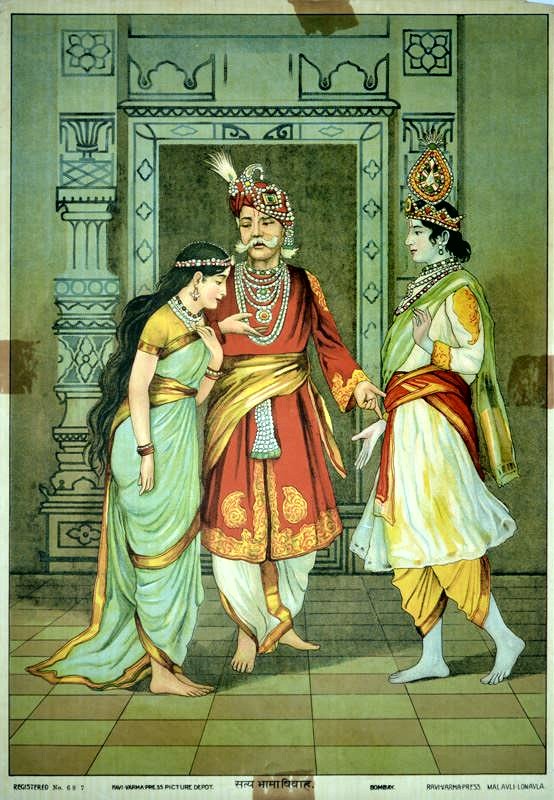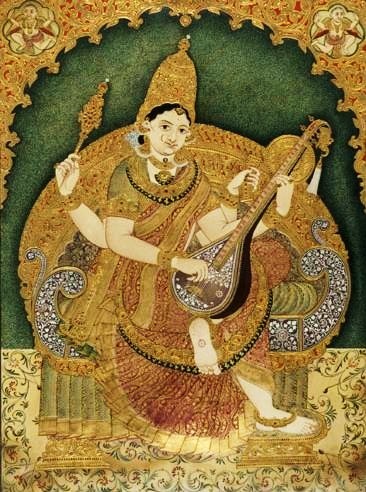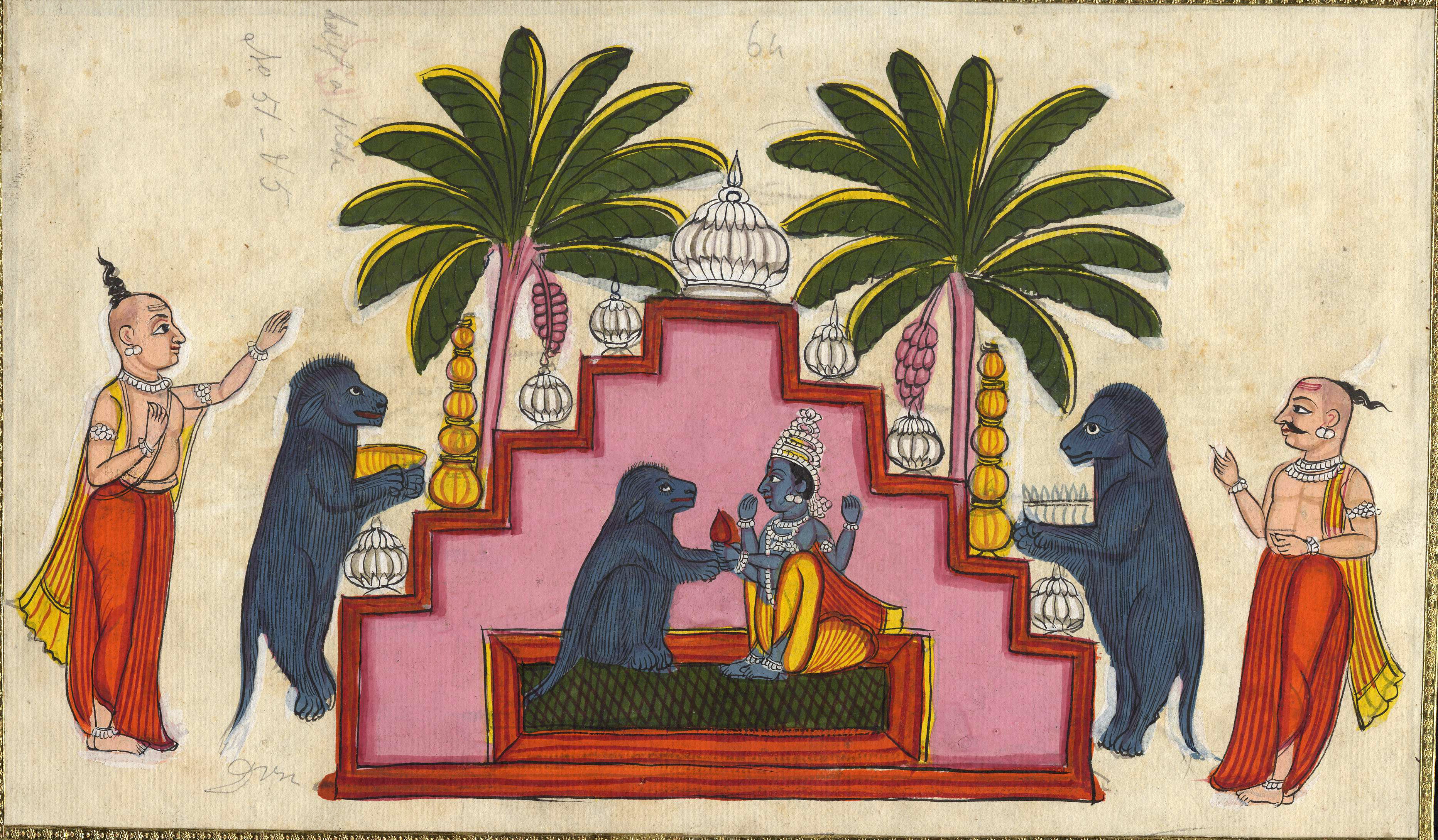|
Satyabhama
Satyabhama, also known as Satrajiti, is a Hindu goddess and the third queen-consort of the Hindu god Krishna. Satyabhama is described as the incarnation of Bhudevi, the goddess and the personification of the earth. She aided Krishna in defeating the asura Narakasura. Legend Marriage to Krishna Satyabhama was the daughter of Yadava King Satrajita, the royal treasurer of Dwaraka, who was the owner of the Syamantaka jewel. Satrajit, who secured the jewel from the sun-god Surya and would not part with it even when Krishna, the king of Dvaraka, asked for it saying it would be safe with him. Shortly thereafter, Prasena, the brother of Satrajita, went out hunting wearing the jewel but was killed by a lion. Jambavan, known for his role in the Ramayana, killed the lion and gave the jewel to his daughter Jambavati. When Prasena did not return, there were accusations of Krishna murdering Prasena for stealing the jewel for himself. Krishna, in order to remove the stain on his reput ... [...More Info...] [...Related Items...] OR: [Wikipedia] [Google] [Baidu] |
Ashtabharya
The Ashtabharya or Ashta-bharya(s) is the group of eight principal queen-consorts of Hindu god Krishna, the king of Dvaraka in the Dvapara Yuga (epoch). The most popular list, found in the ''Bhagavata Purana'', includes: Rukmini, Satyabhama, Jambavati, Kalindi, Mitravinda, Nagnajiti, Bhadra, and Lakshmana. Variations exist in the ''Vishnu Purana'' and the '' Harivamsa'', which includes queens called Madri or Rohini, instead of Bhadra. Most of them were princesses. In Hinduism, all of Krishna's consorts including Radha are revered as the avatars of the goddess Lakshmi while the Gopis of Braj are considered as Radha's manifestations. Rukmini, the princess of Vidarbha was Krishna's first wife and chief queen (''Patrani'') of Dvaraka. She is considered as the avatar of Sridevi, the goddess of prosperity. Satyabhama, the third wife, a Yadava princess, is considered as Lakshmi's aspect of the earth-goddess Bhudevi. Jambavati is believed to be the manifestation of the third aspect o ... [...More Info...] [...Related Items...] OR: [Wikipedia] [Google] [Baidu] |
Narakasura
Naraka, also known as Narakasura (), is an asura king in Hindu mythology. In Assamese tradition, he is regarded as the legendary progenitor of all three dynasties of Pragjyotisha-Kamarupa, and the founding ruler of the legendary Bhauma dynasty of Pragjyotisha. Though the myths about Naraka are first mentioned in the Mahabharata, later texts embellish them. According to later post-Vedic texts such as the Brahma Purana and Vishnu Purana, he was the son of Bhudevi, fathered either by the Varaha incarnation of Vishnu or Hiranyaksha. He is claimed as one who established Pragjyotisha. He was killed by Krishna and Satyabhama. His son Bhagadatta—of Mahabharata fame—succeeded him. The 10th/11th-century Kalika Purana embellishes the myths further and he is claimed to have come from Mithila and said to have established the kingdom of Pragjyotisha after overthrowing the last of the Kirata kings, Ghatakasura, of the Danava dynasty. It was foretold that he would be destroyed by a lat ... [...More Info...] [...Related Items...] OR: [Wikipedia] [Google] [Baidu] |
Satrajit
Satrajit (), also rendered Satrajita, is a Yadava king in Hinduism. He is the father of the goddess Satyabhama, Krishna's third wife. He is described to be a great devotee of Surya, the sun god. He is known for his role in the legend of the Syamantaka jewel. Legend Gaining the Syamantaka The Bhagavata Purana narrates that Satrajit was a great devotee of sun god, Surya. Greatly pleased, Surya offered him the dazzling Syamantaka as a present, which had the power of conferring great wealth upon its owner. When Satrajit wore the jewel, its brilliance was such that he was mistaken as the sun god himself. During a meeting, Krishna asked Satrajit to let King Ugrasena have the jewel, so that it could be used for the good of all. Proud of his possession, Satrajit refused to part with the Syamantaka. Disappearance of the jewel One day, Satrajit's brother, Prasena, borrowed the jewel from Satrajit, and went into a forest for hunting. However, a lion killed him, took the jewel, and ... [...More Info...] [...Related Items...] OR: [Wikipedia] [Google] [Baidu] |
Satrajita
Satrajit (), also rendered Satrajita, is a Yadava king in Hinduism. He is the father of the goddess Satyabhama, Krishna's third wife. He is described to be a great devotee of Surya, the sun god. He is known for his role in the legend of the Syamantaka jewel. Legend Gaining the Syamantaka The Bhagavata Purana narrates that Satrajit was a great devotee of sun god, Surya. Greatly pleased, Surya offered him the dazzling Syamantaka as a present, which had the power of conferring great wealth upon its owner. When Satrajit wore the jewel, its brilliance was such that he was mistaken as the sun god himself. During a meeting, Krishna asked Satrajit to let King Ugrasena have the jewel, so that it could be used for the good of all. Proud of his possession, Satrajit refused to part with the Syamantaka. Disappearance of the jewel One day, Satrajit's brother, Prasena, borrowed the jewel from Satrajit, and went into a forest for hunting. However, a lion killed him, took the jewel, and ... [...More Info...] [...Related Items...] OR: [Wikipedia] [Google] [Baidu] |
Krishna
Krishna (; sa, कृष्ण ) is a major deity in Hinduism. He is worshipped as the eighth avatar of Vishnu and also as the Supreme god in his own right. He is the god of protection, compassion, tenderness, and love; and is one of the most popular and widely revered among Indian divinities. Krishna's birthday is celebrated every year by Hindus on Krishna Janmashtami according to the lunisolar Hindu calendar, which falls in late August or early September of the Gregorian calendar. The anecdotes and narratives of Krishna's life are generally titled as ''Krishna Leela''. He is a central character in the ''Mahabharata'', the '' Bhagavata Purana'', the ''Brahma Vaivarta Purana,'' and the '' Bhagavad Gita'', and is mentioned in many Hindu philosophical, theological, and mythological texts. They portray him in various perspectives: as a god-child, a prankster, a model lover, a divine hero, and the universal supreme being. Quote: "Krsna's various appearances as a di ... [...More Info...] [...Related Items...] OR: [Wikipedia] [Google] [Baidu] |
Syamantaka
Syamantaka (Sanskrit: श्यामन्तक) is perhaps the most famous jewel featured in the Hindu scriptures, supposed to be blessed with magical powers. It is described to be a ruby. The jewel is described to protect its owner if they were virtuous and good, but bring evil to them if they were not. Origin The story of Syamantaka appears in the Vishnu Purana and the Bhagavata Purana. The jewel originally belonged to the God of the Sun, Surya, who wore it around his neck. It was said that whichever land possessed this jewel would never encounter any calamities such as droughts, floods, earthquakes or famines, and would always be full of prosperity and plenitude. Wherever the jewel remained, it would produce for the keeper eight ''bhāras'' of gold daily. ("Four rice grains are called one guñjā; five guñjās, one paṇa; eight paṇas, one karṣa; four karṣas, one pala; and one hundred palas, one tulā. Twenty tulās make up one bhāra.") Since there are about 3,700 ... [...More Info...] [...Related Items...] OR: [Wikipedia] [Google] [Baidu] |
Krishna Narakasura
Krishna (; sa, कृष्ण ) is a major deity in Hinduism. He is worshipped as the eighth avatar of Vishnu and also as the Supreme god in his own right. He is the god of protection, compassion, tenderness, and love; and is one of the most popular and widely revered among Indian divinities. Krishna's birthday is celebrated every year by Hindus on Krishna Janmashtami according to the lunisolar Hindu calendar, which falls in late August or early September of the Gregorian calendar. The anecdotes and narratives of Krishna's life are generally titled as ''Krishna Leela''. He is a central character in the ''Mahabharata'', the ''Bhagavata Purana'', the ''Brahma Vaivarta Purana,'' and the ''Bhagavad Gita'', and is mentioned in many Hindu philosophical, theological, and mythological texts. They portray him in various perspectives: as a god-child, a prankster, a model lover, a divine hero, and the universal supreme being. Quote: "Krsna's various appearances as a divine her ... [...More Info...] [...Related Items...] OR: [Wikipedia] [Google] [Baidu] |
Bhudevi
Bhumi ( sa, भूमि, Bhūmi), also known as Bhudevi and Vasundhara, is a Hindu goddess who is the personification of the Earth. She is a consort of the god Vishnu. According to Vaishnava tradition, she is the second aspect of Vishnu's consort, Lakshmi, along with the aspects of Sridevi and Niladevi. Varaha, the third avatar of Vishnu, saved her from the demon Hiranyaksha and later married her, making her one of his consorts. She is regarded as the mother of Narakasura, Mangala, and Sita. Etymology and iconography The name "Bhūmi" is Sanskrit word for "earth". The version "Puhumi" is the equivalent in Old Awadhi. She is known by various names such as Bhuvati, Bhuvani, Bhuvaneshwari, Avni, Prithvi, Varahi, Dharti, Dhaatri, Dharani, Vasudha, Vasundhara, Vaishnavi, Kashyapi, Urvi, Ira, Mahi, Ela, Vasumati, Dhanshika, Vasumati, Hema, and Hiranmaya. Bhudevi is depicted as seated on a platform that rests on the back of four elephants, representing the four cardinal directions. S ... [...More Info...] [...Related Items...] OR: [Wikipedia] [Google] [Baidu] |
Jambavati
Jambavati () is chronologically the second ''Ashtabharya'' of the Hindu god Krishna. She is the only daughter of the bear-king Jambavan. Krishna marries her when he defeats her father, Jambavan, in his quest to retrieve the stolen Syamantaka jewel. Nomenclature Jambavati, a patronymic, means daughter of Jambavan. Sridhara, a commentator on the ''Bhagavata Purana'', identifies her with Krishna's wife Rohini. However, another commentator Ratnagarbha disagrees. The ''Harivamsa'' also suggests that Rohini may be an alternate name of Jambavati. Jambavati is also given the epithets Narendraputri and Kapindraputra. Legend In the epic ''Mahabharata'', Jambavan is introduced as Jambavati's father. The ''Bhagavata Purana'' and the ''Harivamsa'' calls him the king of bears. Jambavati is an incarnation of the goddess Lakshmi, along with the junior wives of Krishna, as well as the Ashtabharya. Marriage to Krishna The marriage of Jambavati and Satyabhama to Krishna is closely linked w ... [...More Info...] [...Related Items...] OR: [Wikipedia] [Google] [Baidu] |
Bhanu
*
{{Disambiguation ...
Bhanu may be: * an epithet of the deity Surya *Eldest son of the Hindu deities-Shri Krishna and Devi Satyabhama * the name of a place in Nepal: **Bhanu Municipality, the current municipality **Bhanu, Nepal, the former VDC ** * a given name; notable people with the name include: ** Muktha (actress), stage name Bhanu ** Bhanu (Tamil militant) ** Bhanu Bandopadhyay, Indian actor ** Bhanubhakta Acharya, Nepali writer See also * Banu (other) Banu or BANU may refer to: * Banu (name) * Banu (Arabic), Arabic word for "the sons of" or "children of" * Banu (makeup artist), an Indian makeup artist * Banu Chichek, a character in the ''Book of Dede Korkut'' * Bulgarian Agrarian National Union ... [...More Info...] [...Related Items...] OR: [Wikipedia] [Google] [Baidu] |
Aditi
Aditi (Sanskrit: अदिति, lit. 'boundless' or 'limitless' or 'innocence') is an important Vedic goddess in Hinduism. She is the personification of the sprawling infinite and vast cosmos. She is the goddess of motherhood, consciousness, unconsciousness, the past, the future, and fertility. She is the mother of the celestial deities known as the adityas, and is referred to as the mother of many deities. As celestial mother of numerous beings, the synthesis of all things, she is associated with space (''akasha'') and with mystic speech (''Vāc''). She may be seen as a feminine form of Brahma, and associated with the primal substance (''mulaprakriti'') in the Vedanta. She is mentioned more than 250 times in the ''Rigveda,'' the verses replete with her praise. Family Aditi is the daughter of Daksha and Asikni (Panchajani). The ''Puranas'', such as the ''Shiva Purana'' and the ''Bhagavata Purana'', suggest that Daksha married all of his daughters off to different people ... [...More Info...] [...Related Items...] OR: [Wikipedia] [Google] [Baidu] |
Ramayana
The ''Rāmāyana'' (; sa, रामायणम्, ) is a Sanskrit literature, Sanskrit Indian epic poetry, epic composed over a period of nearly a millennium, with scholars' estimates for the earliest stage of the text ranging from the 8th to 4th centuries BCE, and later stages extending up to the 3rd century CE. ''Ramayana'' is one of the two important epics of Hinduism, the other being the ''Mahabharata, Mahābhārata''. The epic, traditionally ascribed to the Maharishi Valmiki, narrates the life of Sita, the Princess of Janakpur, and Rama, a legendary prince of Ayodhya city in the kingdom of Kosala. The epic follows his fourteen-year exile to the forest urged by his father King Dasharatha, on the request of Rama's stepmother Kaikeyi; his travels across forests in the South Asia, Indian subcontinent with his wife Sita and brother Lakshmana, the kidnapping of Sita by Ravana – the king of Lanka, that resulted in war; and Rama's eventual return to Ayodhya to be crowned kin ... [...More Info...] [...Related Items...] OR: [Wikipedia] [Google] [Baidu] |









